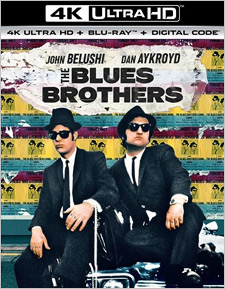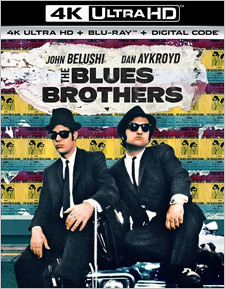Blues Brothers, The (4K UHD Review)

Director
John LandisRelease Date(s)
1980/1998 (May 20, 2020)Studio(s)
Universal Pictures (Universal Pictures Home Entertainment)- Film/Program Grade: A
- Video Grade: A-
- Audio Grade: B+
- Extras Grade: B
Review
Funny men Dan Aykroyd and John Belushi star in this raucous comedy about a pair of musical con men on a mission from God. Based on a routine the pair developed to warm up the audience (and later performed) on NBC’s Saturday Night Live, The Blues Brothers begins with motorhead Elwood Blues (Aykroyd) picking up his brother Jake (Belushi), who’s just been released from prison. Their first stop? The Saint Helen of the Blessed Shroud Orphanage, where both grew up. Elwood reminds Jake that he promised to visit Sister Stigmata (a.k.a. The Penguin) when he got out. It’s there they learn that the Church has decided not to pay $5,000 in back taxes owed to the county; unless the money is found, the orphanage will be closed. Determined to help but unable to decide how, Jake and Elwood take in a sermon by the Reverend Cleophus James (none other than James Brown) when Jake suddenly sees the light: They can get their old R&B band back together to play a few gigs and earn the money! So Jake and Elwood set out on a “holy” mission to track down their former bandmates. What follows is one of the most bizarre and funny series of musical numbers, car chases, and general misadventures ever captured on film.
Where else can you find rip-roaring comedy, 50-car pile-ups, and performances by some of the finest rhythm and blues musicians ever assembled, including Brown, Cab Calloway, Ray Charles, Aretha Franklin, and John Lee Hooker? Directed by John Landis (Animal House, An American Werewolf in London), The Blues Brothers has a little of everything and something for everyone. Heating up the action is the fact that virtually everybody in the film is out to get Jake and Elwood for one reason or another. There’s an ex-girlfriend hell bent on revenge (Carrie Fisher), Jake’s portly parole officer (John Candy), a band of Illinois Nazis... even an RV full of good old boys (a country band called, appropriately, The Good Old Boys). Throw in Jake and Elwood’s ragtag band, literally hundreds of police officers, Illinois state troopers, and tank-driving National Guardsmen, one ninja nun (which, as a recovering Catholic school attendee, always leaves me in stitches), and a dash of the Peter Gunn Theme, and you’ve got an all-time comedy classic.
The Blues Brothers was shot photochemically in 35 mm format using Panavision Panaflex cameras and spherical lenses, then finished on film in the 1.85:1 “flat” aspect ratio for its theatrical release. Universal’s new Ultra HD presents both the 133-minute theatrical cut and the 148-minute extended edition (first released on DVD in 1998) in 4K—you choose the version when you start the film. Thankfully, it does appear that the studio has gone back to the original camera negative for a new 4K scan. The opening shots are a little dark and, with the optical titles, they’re scanned from the interpositive. But once the film starts proper, the increase in fine detail and texturing is significant. You’ll be happy to know that there’s plenty of natural grain in evidence, but it’s never distracting. This image doesn’t compare to a modern film on the format. But as a diehard fan, I can tell you from experience that The Blues Brothers has never looked better. Contrast is improved, with deeper blacks, and the HDR grade boosts the highlights just a little to make them more lifelike (note that only HDR10 is available). What’s most improved is the film’s palette—the colors look richer and more naturally saturated here than ever before. You’ll notice it in the golden sunrise as Jake emerges from Joliet, in the red-and-blue police car “rollers” and blue uniforms, in the stained glass windows of the Triple Rock Baptist Church, in the neon lights of Bob’s Country Bunker… even the golden doors of the Cook County Assessor’s Office. Much of the final car chase through the streets of Chicago occurs in the “magic hour” before sunset—something I’d never actually noticed before this (and I’ve seen the film many times). Again, this is not a reference-quality image, but it’s perfect for The Blues Brothers, and that’s the whole point.
Every bit as pleasing as the image is the film’s upgraded sound mix, which is available on the 4K disc in object-based DTS-X. The soundstage is medium wide—somewhat more expansive than the previous Blu-ray mix—with light but smooth use of the surround channels for panning and atmospheric effects. The dialogue and sound effects are clean and natural, as always. But where the mix really shines is in the soundtrack, which features one iconic R&B track after another. The fidelity of the lossless music is outstanding, with beefy low end and rich mid-tones. Again, this doesn’t sound like a modern film mix, but it sounds exactly as it should… and better than ever before. Note that additional audio is also available in French 5.1 DTS (for the theatrical version only), while optional subtitles include English SDH, French, Spanish, Danish, Finnish, Norwegian, Swedish, and Hindi.
Universal’s Ultra HD release is a 2-disc set, with both versions of the film on 4K Ultra HD and both versions in HD on Blu-ray as well. Note that this is the exact same Blu-ray the studio released in 2011—it has not been sourced from the new remaster. Both the 4K disc and the Blu-ray include the following extras, carried over from the original DVD release:
- Stories Behind the Making of The Blues Brothers (SD – 56:21)
- Transposing the Music (SD – 15:18)
- Remembering John (SD – 9:41)
The Blu-ray further adds:
- Theatrical Trailer (SD – 4:25)
- D-Box Motion Code (for those who may still have D-Box motion control systems)
Stories Behind the Making of The Blues Brothers was produced by our old friend JM Kenny. It’s terrific—almost an hour long, full of great stories and anecdotes. There’s a funny (and touching) moment, where Aykroyd recalls a night during filming when Belushi disappeared. A quick search of a nearby neighborhood revealed that John had simply invited himself into a stranger’s house, helped himself to a sandwich and a glass of milk, then crashed on the guy’s couch! You can see how much Aykroyd appreciates and misses his old friend as he tells the story.
Transposing the Music is a nice little retrospective on the film and its impact in revitalizing R&B music (and the careers of many of its musicians). It features interviews with Landis, Aykroyd, Paul Shaffer, some of the band members, and Judy Belushi (John’s wife, who also helped create the history of the characters back in the day). Finally, there’s Remembering John, a tribute to the man who made Joliet Jake live and breathe. Absent (from the original DVD release) are the gallery of behind-the-scenes production photographs, the video introduction by Aykroyd, and the Going Rounds: A Day on The Blues Brothers Tour featurette (SD – 7 mins). You do at least get the film’s trailer (on the Blu-ray), and there’s a Digital code on a paper insert.
It should be noted that Going Rounds isn’t really missed; it was a basically a few minutes of performance footage of the “new” Blues Brothers (with Jim Belushi standing in for his late brother) on stage at The House of Blues. (Sadly, once John died, so did my interest—and the less said about the sequel, Blues Brothers 2000, the better.) As a quick side note, if you really want more performance footage of Jake and Elwood—as in GOOD footage—I recommend you skip the sequel and get yourself a copy of Rhino’s The Best of the Blues Brothers DVD. It features Belushi and Aykroyd (in character as Jake and Elwood) giving an interview in which they talk about the origins of their act. This leads into TONS of vintage performance footage, among which you’ll find most of their 1970s Saturday Night Live appearances (including the classic Killer Bees number), as well as concert footage from their U.S. tour in 1979. It’s a must-have if you’re a fan.
The one thing I do wish had been included are the so-called “lost” audio tracks: The Blues Brothers performing Johnny Horton’s Sink the Bismarck at Bob’s Country Bunker (from a scene that was cut), along with Murph and The Magic Tones’ versions of Tony Renis’ Quando, Quando, Quando (only part of which appears in the film) and Billy Joel’s Just the Way You Are (only an instrumental version is heard in the film). The film footage of Sink the Bismarck is believed to be lost, but high quality audio recordings of all three songs still exist. Way back when the film was released on Collector’s Edition DVD, I managed to track down MP3 versions (with the help of Wayne Ross of the Mad Music Archive) from an August 10th, 1980 radio broadcast of The Dr. Demento Show (which featured Landis as a co-host to promote the film). For years we hosted them here on The Bits, but recently we provided them to Bits reader Mark C. for uploading to Archive.org. So now you can all find them via this link for free (Sink the Bismarck especially is recommended). Enjoy!
The Blues Brothers is not only one of the American cinema’s all-time great musical comedies, it’s an amazing slice of R&B history too. This film is so good it fills me with joy every time I see it. And I think we could all use a little more of that right now. If you love The Blues Brothers as much as I do, Universal’s new 4K remaster is highly welcome and a must have. Don’t miss it.
- Bill Hunt
(You can follow Bill on social media at these links: Twitter and Facebook)

